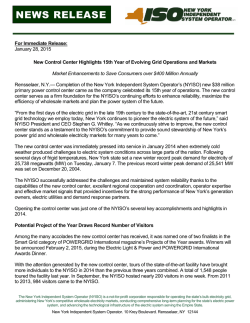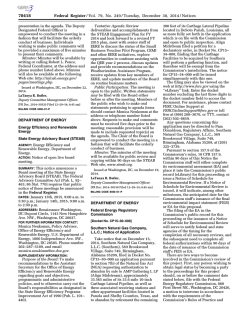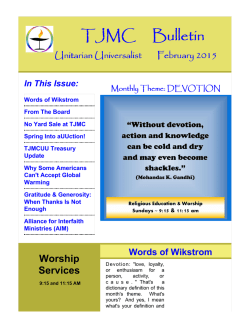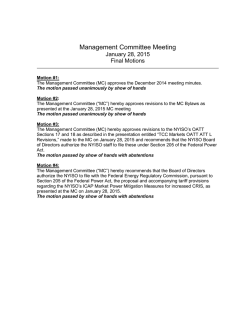
Current Newsletter
LY NX EL ECT RI C CU R R EN T S JANUARY 2015 NEWSLETTER EDITOR’S NOTE INSIDE THIS ISSUE FERC UPDATES 2 PJM 2 NYISO 2 US ENERGY 3 US ENERGY MARKETS 4 ISO-NE UPDATES 4 NY STATE UPDATES 4 NYSERDA PON UPDATES 5 GLOSSARY OF ACRONYMS 5 NYISO SCR CURTAILMENT 6 JANUARY CALENDAR 6 IMPORTANT FUTURE DATES 6 HISTORICAL FLAT DAM PRICING 7 CURRENT PROJECTED PRICING 7 GREEN ENERGY 7 2014 has been an interesting year for energy. On a positive note, energy is getting the attention it deserves as a major factor for modern civilization. Society wants reliable, efficient, environmentally responsible and reasonable priced energy. While these attributes sound ideal, they are at odds with each other as reflected by the actions of the various proponents of these attributes. For example renewable energy and reliability are at odds. Solar power or wind is not consistent in their output and in many applications even Hydro does not deliver consistent capacity output therefore challenging reliability. Fossil fuels are reliable and deliver consistent output but are not environmentally responsible. Nuclear power is environmentally responsible in terms of carbon emissions but has cost limitations. As a result we have judicial rulings, state regulators developing new marketing rules and plans, litigation, Congressional hearings, national energy conferences and federal agencies struggling with energy laws and jurisdiction issues so they can satisfy their mission goals. Technical conferences are scheduled by FERC to start Feb 19, 2015 for the purpose of reviewing the impact of the latest wave of EPA regulations. The EPA Clean Power Plan’s impact on reliability, markets, operation of the grid and grid infrastructure will be the focus of these conferences. Currently the conferences are scheduled in Washington DC, St. Lois Missouri and Denver Colorado. Congressional leaders in energy committees are in favor of the hearings and urge FERC to become more proactive with EPA to insure, costs, technical feasibility, and grid reliability are factored into EPA policies. Without FERC’s input, the energy markets will continue facing uncertainty, costly capital investments and challenges to reliability with potential economic harm for the nation. EIA, the Energy Information Administration projects winter natural gas prices to average $3.98 per MMBTU for the season. November gas usage was up slightly as colder November temperatures in the northeast slowed down injection and increased heating load consumption. Revised storage numbers for natural gas are at 1,431 BCF. While November degree days were 18% above normal EIA projects this winter will be 1% below average. Coal generation is expected to have a 39% market share as it continues to lose market share to natural gas. However, cost per MMBTU is beginning to favor coal over natural gas. Hearings with the incoming Congress may modify EPA regulations and coal market shares could improve. Currently MATS, Ozone regulation and Clean Power Plan are major concerns for coal producers. We wish friends, families, business associates, and customers all the best and a prosperous New Year. We at Lynx will work to keep you informed and provide stellar service to keep you competitive. customers that are dropping your services. Distribution companies will be referred to as utility or utilities in this write up. More details can be found on the NY-PSC website under the following documents: CASE 12-M -0476, CASE-M-1343, CASE-06M-0647 and CASE 98-M-0667. The key points are listed below for your convenience: ▪ Electric switching time has been reduced to 5 days from the previous 15 days ▪ Customers have 3 business days to cancel their enrollment contract ▪ Enrollment requests must be submitted to a distribution utility 5 days prior to supplier switch ▪ Natural gas switch timeline is 15 days ▪ Suppliers can submit change requests after they have a valid customer authorization and valid third party notification ▪ On receipt of the request for switch the utility has one day to respond to the supplier by ei- ther accepting or rejecting with a valid reason ▪ After acceptance by the utility, the utility sends a notice to the current supplier notifying them of the change ▪ Change of a supplier will take place after the next scheduled meter read unless other arrangements are made with the utility, such as paying for a special meter read or new service Our staff can assist you if you need additional support. TIP OF THE MONTH The New York PSC has issued new rules governing retail power switching rules. Energy suppliers have multiple names. In the new PSC rules marketers, retailers, providers or suppliers are referred to as ESCO’s. For simplicity purposes we will call them suppliers in this update. The Uniform Business Rules are effective 12/15/2014 and are important so that you as a supplier understand the timelines and methodology of signing up customers or reporting LYNX ELECTRIC CURRENTS Page 2 FERC UPDATES FERC has approved a compliance waiver for Kansas coal power plant, Nearman Creek, from EPA MATS. The one year waiver allows the Kansas BPU to find a replacement for 235 MW of current plant output. According to FERC, the Nearman One plant is the only coal plant to date to receive an extended waiver. Any additional requests for a waiver must be submitted 180 days before the April 15, 2015 MATS implementation date. FERC based their approval for the Nearman One plant to continue operation on reliability purposes, allowing BPU to maintain a 12% reserve margin. The latest FERC Order requires ISO/RTO’s to provide a fuel mix and fuel availability update to FERC. Chairman La Fleur wants to ensure that capacity markets and reliability standards are maintained. Many of the recent rule changes are giving generators more flexibility to meet capacity needs. La Fleur stated the commission will evaluate on a regional basis, as resources and fuel mix vary by region. Natural gas availability has received the majority of the scrutiny; however other resources including renewables impact power. DG and DR are also factors in maintaining reliability. It appears Senate confirmation for new FERC Commissioner nominee Colette Honorable has been approved. Ms. Honorable has support from Democrat and Republican senators based on her work as Arkansas PSC Chairman. Having five seated FERC commissioners will avoid future ties as has been the case the past few months. The long awaited FERC appeal to the Solicitor General for a Supreme Court hearing appears to be moving forward. FERC is challenging the US Court of Appeals ruling which invalidated FERC Order 745. Order 745 mandates receiving full LMP payments for DR contribution to capacity markets. In the appeal FERC is insisting DR is an integral part of their wholesale market strategy and the Court of Appeals does not have the right to interfere with wholesale electric markets. Former FERC Chairman Jon Wellinghoff, now a strategic advisor for AEMA, is preparing remarks to address the Supreme Court hearing in this matter. Mr. Wellinghoff points out that Circuit Court ruling on 745 is inconsistent with the Federal Power Act, and is in fact harmful to competitive markets. Mr. Wellinghoff states that a two to one decision by the District court on a complaint from two entities, PJM and ISO-NE does not justify throwing out 745 and the economic and reliability chaos it is causing. Furthermore, Wellinghoff, maintains FERC has jurisdiction over wholesale power and the circuit court did not review the impact of their decision on wholesale US markets. Currently the DR program has a stay order issued by the US DC circuit court of Appeals until the Supreme Court issues a ruling. A hearing is expected this spring 2015. In the meantime DR markets continue to function per FERC rules and under Order 745. PJM UPDATES PJM has received a stop payment order from FERC. The order impacts payments for Reactive Power from PJM to idle power plants. FERC position is that shut down plants should not receive payment for Reactive Power. The DC-PUC is warning retailers that failing to report their fuel mix to the PUC will result in a $10,000 per violation fine. Fuel mix reports are due June 1 and Dec.4 each year. The reports consist of generator fuel mix and associated emissions for the previous calendar year. They may use PJM average power mix data. Some suppliers are submitting the PJM system data instead of the required PJM residual mix or actual fuel mix data. There is also a reporting for REC’s accounting. The PUC is giving suppliers 2 weeks to respond or face being fined. Policy Act was passed to allow FERC to make critical infrastructure decisions ensuring capacity was maintained, something the Clean Power Plan may have overlooked. NYISO points out that RGGI has already reduced CO2 emissions by over 41 % and 53% of the power produced in NY is produced by non-emitting generation. To apply new standards of CPP to a state that has already achieved impressive reduc- tions is unreasonable and the EPA needs to modify their reduction numbers for NY. FERC Commissioner Moeller voiced his concern over potential costs of CPP, stating implementation could cost ratepayers hundreds of billions of dollars. Implementing CPP would impact NY ratepayers, already paying the highest US energy prices. FERC points out that EPA paper regulations cannot override basic laws of physics and CPP must be subjected to greater scrutiny and NYISO UPDATES NYISO has joined the criticism of the EPA Clean Power Plan. The ISO is concerned about the oil fueled power plants in NYC, which are needed to maintain sufficient capacity. EPA staff calculated that oil fueled plants can be cut in NYC and still maintain reliability. FERC points out that Congress recognizes the population density and critical financial institutions in NYC and reliability is critical. The fact that the 2005 Energy modified as needed. NYISO anticipates having sufficient capacity for this winter. At the present time NYISO has 39,803 MW of installed capacity. The estimated peak demand is 26,300 for this winter. In addition to installed capacity the ISO has 843 MW of DR and has the ability to import 1078 MW of outside the region power. NYISO CEO Stephen Whitley pointed out that improvements in market JANUARY NEWSLETTER Page 3 US ENERGY ERCOT has run the numbers projecting that EPA’s Clean Power Plan will diminish coal fuel plants to 13% of the state generation by 2029. Natural Gas, while cleaner, is also being targeted by EPA in an effort to reduce CO2 emissions. Their goal is to reduce any carbon based fuels from the current 60% energy mix to 20% by 2029. The Texas Power Planners are concerned about Reserve Capacity dropping to 2%. In comparison, Northeast states have reserve capacity above 10%. Meanwhile the push in ERCOT is wind and solar generation. EPA is re-evaluating and justifying their impact with their new Clean Power Plan. With focus on renewables and energy efficiency upgrades, the estimated costs to consumers can vary between $7 and $10 billion by 2020. EPA claims that because energy is only part of the cost of electricity to consumers, their actual utility bills vary but EPA anticipates a 7% increase by 2020. Lower costs for renewable energy and new energy efficiency upgrades will make them more competitive with conventional generation. In its continued effort to regulate, the EPA has issued new ozone level standards. The new measure drops ozone levels from 75 to 66 ppm by 2025. The EPA claims that by reducing NOx and VOx , the health benefits will save the country $6 to $13 billion per year. NOx and VOx are by-products of industry, power plants, and transportation, all of which are been targeted along with conventional fossil fuels. EPA administrator Gina McCarthy points out “the new regulations empower Americans with updated air quality information and protects our loved ones”. Ed (If all the new regulations are implemented we will all find more time to be outdoors as industry will reduce production and need fewer employees, given us the opportunity to enjoy the clean air). The EPA’s Clean Power Plan calling for CO2 reduction in power plants by 2030 is based on a 2005 base- line. The steps that EPA proposes includes energy efficiency programs, more renewable energy generation, and using natural gas to replace coal. IRC (ISO/RTO Council) has requested that EPA conduct a feasibility study to determine the impact of the Clean Power Plan on grid reliability and the economics of power purchases. A thorough study should include impacts to state policy and laws regarding power mix, reliability and social policies. The study should also address the impact on ISO and RTO’s, their ability to comply with FERC Orders and the impact to regional grid structures. The rush to contain CO2 without analysis of energy laws, and systems that have been developed over 80 years can be viewed as reckless and possibly harmful to the US economy. IRC has also requested that EPA establish “Safety Valves” that could respond to unforeseen reliability impacts caused by the new EPA regu- The PSC wants potential developers to submit their recommendations to the PSC staff by January 19. After reviewing all options the PSC will present their recommendations in August/September of 2015. NYISO will co-ordinate cost recovery and structure tariffs to provide capital to fund the selected options. The tariff will be based on cost/benefits ratios for downstate customers. A risk sharing process will be established by the PSC for developers. NYISO has analyzed data from the new and repowered power plants in the lower Hudson region and determined that 1,900 MW of new capacity will be coming on line. That information may satisfy the NY-PSC request for NYISO to prepare selection, cost analysis and new tariffs to cover the costs of new grid infrastructure and power plants. The ISO points out that the new Lower Hudson Capacity Zone has stimulated sufficient investment by the merchant generators to satisfy immediate future capacity needs. The new and refurbished power plants will provide the much needed capacity for the region; however the ISO points out new transmission lines are still needed to secure reliability. NYISO UPDATES CONTINUED rules and additional natural gas pipelines into NYC will help control volatility and should avoid a repeat of last winter price spikes. Many NY generators are now dual fuel having the ability to switch from natural gas to fuel oil. NYISO is a summer peaking ISO as 70% of NY households us AC for summer cooling while only 10% use electric for winter heating. That number may be underrated as many commercial office spaces have small electric heaters in office spaces to supplement the heat. An action item resulting from the NY-PSC REV has the PSC looking at transmission congestion in the Mohawk Hudson Valley corridors. The study is in response to complaints of transmission congestion causing higher rates in the lower Hudson region. Since transmission lines bring power to the distribution utilities regulated by the NYSIO, they will be involved in establishing tariffs to fund the implementation of the solutions. Potential solutions include: ▪ Adding more transmission lines ▪ Developing more renewable energy generation ▪ New generating plants ▪ Pushing more energy efficiency/DR ▪ Building more DG facilities. LYNX ELECTRIC CURRENTS Page 4 US ENERGY MARKETS In response to the DC-PSC proposed marketing rules, NEM is questioning the need for the major onerous rules. NEM supports a code of conduct for retailers and points out that rule changes need to balance customer protection with rules that allow suppliers to function and bring retail benefits to the market. The PSC rule changes follow on the heels of the Starion Energy misconduct and resultant fines. The proposed rule changes are burdensome and will increase costs for retailers, thereby reducing benefits to consumers. RESA agrees with NEM and calls for a stakeholder meeting to review the PSC proposed changes. NEM identified a list of proposed rules including: ▪ Archaic written contract requirements ▪ Unnecessary duplication of customer contract authorization ▪ Unjust changes in contract cancelling periods ▪ Duplicative and costly customer notice requirements ▪Vague Commissioning Compliance requirements Consumer advocates favor new rules and stricter operational and compliance rules. Senator Martin Heinrich has attempted to resolve the DR dilemma for FERC. The New Mexico senator is concerned about grid reliability and recognizes the need for DR, specifically energy efficiency to keep the US competitive in world markets. However, being this close to the end of the legislative term and dealing with larger issues such as the continued Mid-East crisis, gives the DR measure a slim chance to get on the floor of Congress. The senator has pointed out the current Federal Power Act is 80 years old and needs to be updated as technology and markets have evolved. Natural gas prices have been dropping, bringing electric prices down accordingly. ERC reports that natural gas futures dropped 16% for January 2015, during November trading. Looking forward to 2015-2016-2017, prices are running under $4.00 per MMBTU. Lower gas prices bode well for electric prices as natural gas is the major fuel, displacing coal, used for generation. ISO-NE is reporting they have sufficient natural gas supply for this winter. FERC released numbers that natural gas prices will result in generation prices going up by 84%. Meanwhile natural gas suppliers claim they are injecting shale gas at record numbers and anticipate lower costs for the winter. However gas pipeline con- gestion continues to be a problem. The ISO notes that dual fuel generation with oil storage or on site LNG storage will lessen the pipeline congestion issue. The winter capacity is expected to be around 21,085 MW and ISO generator capacity is around 29,835 MW. Regulators are aware that last winter 11,000 MW of generation went offline because of natural gas shortages. To date, eight plants have installed LNG storage facilities. In addition 1400 MW’s of DR have been contracted. Having taken such measures, it is up to mother nature to see if the preparation and planning by ISO-NE is sufficient to avoid a repeat of last winter. ISO-NE UPDATES The Connecticut PURA approved a rate increase which can send supply prices from $0.06657 per kWh to $0.13308 per kWh. United Illuminating spokesman Michael West points out the PURA rate hike is the default rate and customers should shop for lower prices from suppliers that provide lower prices than the standard offer from utilities. NY STATE UPDATES Concern over reliability is resulting in a must run scenario in NY. The Ginna Nuclear Plant near Rochester NY has been operating at a loss and Exelon, the owner, wants to close the 581 MW plant. The power plant is running under a “Reliability Support Service Agreement” with RG&E, the local utility purchasing the plant output through June of 2014. Since then the plant has been selling their output in the NYISO market at a loss. With support from IPPNY, Gina has a filling with FERC to close the uneconomical plant. The PSC claims the plant output is needed until a new transmis- sion line is built to support RG&E capacity. In addition to FERC regulations, Gina also faces Nuclear Regulatory Commission rules and their retirement protocols. IPPNY’s position is opposed to forcing generators to sell wholesale power at a loss and of course NY-PSC is in charge of reliability and mandating plants to keep running. In the in-term, “out of market” price formats will be used to keep Gina running. New York Suppliers or retailers have filled a complaint with the NY-PSC over ongoing issues with National Grid single billing policy and a plethora of errors, omissions and costly mistakes for market participants. Bill accuracy, errors and blatant omissions impact retailers and are detrimental to retail markets as well as consumer confidence. With the slim margins of suppliers, the utility billing errors also drain valuable human resources of the suppliers in trying to correct mistakes and damage control with impacted customers. As a result retailers or suppliers are demanding immediate resolution from the PSC to correct billing errors or force the utility to allow dual billing so suppliers can do their own billing, provided the utility provides correct supply and capacity usage data. Billing errors according to retailers include: customers not being billed, double billing, failure to bill large accounts, energy use data and billing data not matching along with other mismanagement issues. The carelessness for an international utility company such as Grid is inexcusable. The retailer/suppliers want the PSC to force National Grid to correct their billing activity for the good of the energy market, and all participants in the retail markets. JANUARY NEWSLETTER Page 5 NYSERDA PON UPDATES Current PON’s (Program Opportunity Notices), which are available to qualified customers from NYSERDA. • PON 1219 Existing Buildings: Provides rebates and performance incentives for existing buildings including lighting, motors, generators, HVAC equipment etc. through 12-31-2015. This PON has added natural gas incentives. • PON 1601 New Construction Financial Incentives: Provides incentives for new and remodeled buildings, paying for architectural and engineering services, rebates on electric equipment, appliances, HVAC equipment, and building envelope, through 2015. • PON 1746 Flex Tech: Provides funding for a variety of feasibility and energy related studies through 12-31-2015. • PON 2112 Solar PV Program Financial Incentive through 2015 and was revised in August 2014. • PON 2439 Wind Turbines: This PON pays incentives to certified installers of DG windmills under 2 MW through 2015. • Multi Family Performance Partners: Facilities with 5 or more housing units are eligible for energy audits and energy efficiency funding through 2015. • PON 2456 Industrial and Process Efficiency Program: This PON is can pay up to $4.5 Million per project through Dec. 2015. • PON 2568 CHP Acceleration: Funding for onsite generation with heat recovery (DG/CHP) packaged units through 2015. • PON 2758 Gas Station Back up Power Program. This PON provides emergency power for generators in Downstate gas stations, and will do so until the funding runs out. • PON 2689 Emerging Technologies and accelerated Commercialization through Dec. 2016 • PON 2701 Combined Heat and Power CHP Performance Program through Dec. 2016 •PON 2846 Innovations in Data Center Information & Communications Technology Energy Efficiency: This PON has funding through April 2015. ▪ PON 2828 Renewable Portfolio Standard Customer-Sited Tier Anaerobic Digester Gas to Electricity Through 2015 US ENERGY MARKETS (CONTINUED) lations. PJM notes that EPA CO2 reduction rules by state will negatively impact successful regional programs such as RGGI. The EPA should encourage regional compliance thereby fostering interstate cooperation. Utilities and electric grids are no longer confined to state boundaries, in fact the grid is international with ties between the US and Canada. APPS commented on the Clean Power Plan, stating the plan moved too fast for the industry to raise the capital to make the required changes, which therefore increases the cost for modification and will be a cost burden for ratepayers. Solar energy has increased its contribution to the energy mix and is on track to provide 10% of the US energy generation needs by 2030. Solar generation experienced a phenomenal 77% growth in capacity ac- cording to the Environmental American Research Policy Institute. The rapid growth of solar energy has added 143,000 jobs in 2013 and impacted the market with $15 billion in investment in solar energy. By generating 10% of US electric generation the US can achieve a 50% carbon emission reduction per the EPA Clean Power Plan. EPRI is getting ready to perform an evaluation of a 2 MW Lithium battery installation. The Energy storage system can be used to integrate renewable energy on the grid. Cedartown in Georgia is the selected site for the six acre site using 3,388 solar panels in the solar energy storage initiative. GLOSSARY OF ACRONYMS AEC - Alternative Energy Credits EIA - Energy Information Administration AEMA - American Exploration & Mining Association ERC - Energy Research Council APPS - American Power Producers Association ERCOT - Electric Reliability Council of Texas BPU - Board of Public Utilities IPPNY - Independent Power Producers of NY LNG - Liquid Natural Gas MATS - Mercury & Air Toxic Standards NEM - Newmont Mining Corp RESA - Retail Energy Supply Association REV - Reforming Energy Vision RG&E - Rochester Gas and Electric RGGI - Regional Greenhouse Gas Initiative LYNX ELECTRIC CURRENTS Page 6 January 2015 Sun 4 11 Mon 5 12 Tue Wed 6 7 13 14 Thu 19 20 Sat 1 2 3 8 NYISO ICAP Monthly Auction PJM Monthly Bill Issued by 5 PM 9 10 15 16 NYISO ICAP Monthly Auction Results 18 Fri NYISO ICAP Monthly Auction 17 PJM Monthly Bill Due by 12 21 22 23 24 30 31 Certification 25 26 27 NYISO ICAP Monthly Spot Auction NYISO ICAP Monthly Spot Auction FUTURE DATES January 8-9 NYISO ICAP Monthly Auction 13 NYISO ICAP Monthly Auction Results 15 PJM Monthly Bill Issued by 5 PM 16 PJM Monthly Bill Due by 12 PM 22 Certification 26-27 NYISO ICAP Spot Auction 29 NYISO ICAP Spot Auction Results February 5-6 NYISO ICAP Monthly Auction 10 NYISO ICAP Monthly Auction Results 19 Certification 23-24 NYISO ICAP Spot Auction 26 NYISO ICAP Spot Auction Results 28 29 NYISO ICAP Monthly Spot Auction Results NYISO SCR CURTAILMENT PROGRAM Proposed changes by the NYISO will impact SCR customers. Lynx will keep you informed and updated as changes are approved. Payments for participation in DR programs are up as Governor Cuomo is getting behind peak load reduction programs. Lynx is providing assistance for our customers with event notification and performance verification to meet NYISO requirements. A major obstacle for customers having peak demand less than 500 kW is getting an interval meter installed. Lynx can secure grants for interval meters, and get the meters installed. Many customers willing to participate in NYISO programs need help in determining what items can be curtailed and to determine the kW value of those items to be shut off. Lynx can help your customers determine which loads that can be curtailed (and to what extent). In addition, Lynx can now provide Cummins Generators which can be used for curtailment purposes along with providing protection for property and life during emergencies. Lynx will work with you to get customers registered in a NYISO program. So help your customers get some cash for shedding electric loads during peak load emergency events. ESCO’s or suppliers will also earn funds. With Lynx guidance, you can avoid costly pitfalls and potential fines. Call Lisa Klein or Bert Spaeth in our Lynx office at 716-774-1341. JANUARY NEWSLETTER Page 7 COMMODITY PRICING Historical - Flat DAM Jul-14 Aug-14 Sep-14 Current Projections Oct-14 Nov-14 Dec-14 Jan-15 Feb-15 Mar-15 Flat Flat Flat Jan-15 to Dec-15 Flat Peak Off Peak NYISO-A 34.49 29.38 32.78 31.14 33.11 30.44 48.94 41.80 36.57 36.06 42.72 30.25 NYISO-F 36.39 30.45 31.80 30.76 40.79 35.50 71.86 66.93 46.16 43.36 50.69 36.97 NYISO-J 39.79 32.10 32.91 32.37 42.13 36.23 68.26 60.45 45.62 45.07 54.00 37.29 NYISO-K 46.55 37.00 38.07 38.38 48.07 42.37 73.50 66.12 60.91 56.33 66.98 47.05 PJM-PSEG 38.67 31.56 31.13 31.06 43.16 33.05 58.94 54.16 39.67 40.76 48.84 33.72 PJM-JCPL 38.66 31.33 29.94 30.68 42.64 30.97 55.23 53.20 38.31 39.72 47.68 32.77 PJM-APS 35.73 33.61 34.08 34.53 39.83 32.99 50.21 43.57 37.73 37.23 43.95 31.38 PJM-PECO 38.13 30.35 29.67 29.54 42.46 30.09 54.47 49.55 36.97 37.75 45.18 31.26 PJM-PPL 36.88 30.33 29.30 29.72 41.59 29.92 54.55 49.25 37.83 37.66 45.10 31.17 PJM-DLCO 32.77 31.71 31.54 33.44 39.96 31.94 45.18 38.47 34.83 34.60 40.85 29.16 PJM-PENELEC 36.68 33.12 33.01 33.22 40.47 32.79 51.49 44.88 38.39 37.99 45.19 31.71 PJM-METED 37.41 30.25 28.96 29.99 41.90 29.94 54.77 49.47 37.93 37.82 45.27 31.32 PJM-BGE 42.77 41.29 43.85 41.18 44.15 37.80 60.83 54.94 45.32 44.06 53.16 36.13 ISONE-CT 37.89 30.49 34.54 32.79 48.01 42.39 85.65 68.92 52.92 48.23 56.27 41.22 Note: On-peak is defined as HE08– HE23 Weekdays (less NERC Holidays) Commodity pricing at MWh reflects an estimate of pricing based on current information available at time of printing from various market sources. The prices are not intended to be used as hard data for contractual purposes. Prices are represented in dollar per MWH. GREEN ENERGY As state mandates are phased in, retail suppliers are required to purchase RECs (Renewable Energy Credits) and show documented proof of purchase. Most states require a certain percentage of a supplier’s portfolio be “backed by” RECs. The required percentage increases each year—up to 27% in some states by 2025. Generally, there are three types of RECs and each state mandates a certain mix Solar is the most expensive and Tier or Class II is the least expensive. Failure to purchase the required number/type of RECs results in the forced purchase of Alternative Energy Credits (AECs), which are punitive (as much as ten-times market value). Lynx will assist you in locating cost effective RECs to meet your needs and even handle your reporting requirements. Note: To ease the burden of purchasing annually and the large cash expenditure, Lynx is recommending purchasing REC’s on a quarterly basis to avoid higher prices at the end of the reporting period. Lynx EMS Address: 2680 Grand Island Blvd, Suite 2 Grand Island, NY 14072 Phone: 716-774-1341 Fax: 866-316-8599 Website: www.LynxEMS.com Contacts: Kevin Schoener: [email protected] Lisa Klein: [email protected] Bert Spaeth: [email protected] Dennis O’Leary: [email protected]
© Copyright 2025






